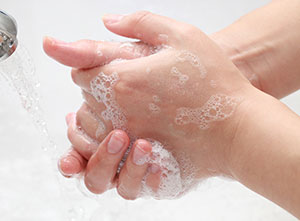
One of the best ways to protect yourself against germs and viruses is to clean your hands. Since 80% of germs and viruses are spread by hands, experts are zeroing in on simple hygiene to help curb the spread of illnesses like the flu.
The Centers for Disease Control (CDC) shows the science behind handwashing and how washing your hands with soap and
water removes germs and viruses from hands.
Here’s how to wash your hands according to the CDC:
- Wet your hands with clean, running water, turn off the tap, and apply soap.
- Why? Using soap to wash hands is more effective than using water alone because the surfactants in soap lift soil and microbes from skin, and people tend to scrub hands more thoroughly when using soap, which further removes
germs.
- Lather your hands by rubbing them together with the soap. Be sure to clean all surfaces on your hands (backs of your hands, between your fingers, under your nails, etc).
- Why? Lathering and scrubbing hands creates friction, which helps lift dirt, grease, and microbes from skin. Microbes are present on all surfaces of the hand, often in particularly high concentration under the nails,
so the entire hand should be scrubbed.
- Scrub your hands for at least 20 seconds.
- Why? Based on several global studies and research, the optimal length of time to wash hands is 20 seconds. This removes more germs from hands than washing for shorter periods.
- Rinse your hands well under clean, running water.
- Why? Soap and friction help lift dirt, grease, and microbes—including disease-causing germs—from skin so they can then be rinsed off of hands. Rinsing the soap away also minimizes skin irritation.
- Dry your hands using a clean towel or air dry them.
- Why? Germs can be transferred more easily to and from wet hands; therefore, hands should be dried after washing.

Germs are Always Lurking
Handwashing helps prevent infections because:
- Germs can enter our bodies through our eyes, nose and mouths. People frequently touch these areas with their hands – which come in contact with an average of 10 million germs per day.
- Germs from unwashed hands can get into food and drinks. Sometimes, germs can even multiply in certain food or drinks under certain conditions and make people sick.
- Germs know no boundaries – unwashed hands can transfer germs to multiple objects and surfaces like door knobs, table tops, toys or keyboards. These germs will linger on the surface until they’re eventually transferred to someone else’s
hands.
- Removing germs through handwashing can help prevent diarrhea and respiratory infections, and could even prevent skin and eye infections.
By changing handwashing behavior, we can help individuals and their communities stay healthy. In fact, by simply washing our hands, we can:
- Reduce the number of people who get sick with diarrhea by 31%
- Reduce diarrheal illness in people with weakened immune systems by 58%
- Reduce respiratory illnesses, like colds, in the general population by 16-21%
- Protect approximately 1 in 3 children who get sick
Ready to improve hand hygiene in your workplace? Implement the Compass® Program from Betco®. Compass is the only program that guides users to proper hand hygiene as recommended by the CDC. Click here to learn more.
To learn more about the science behind handwashing, click here.